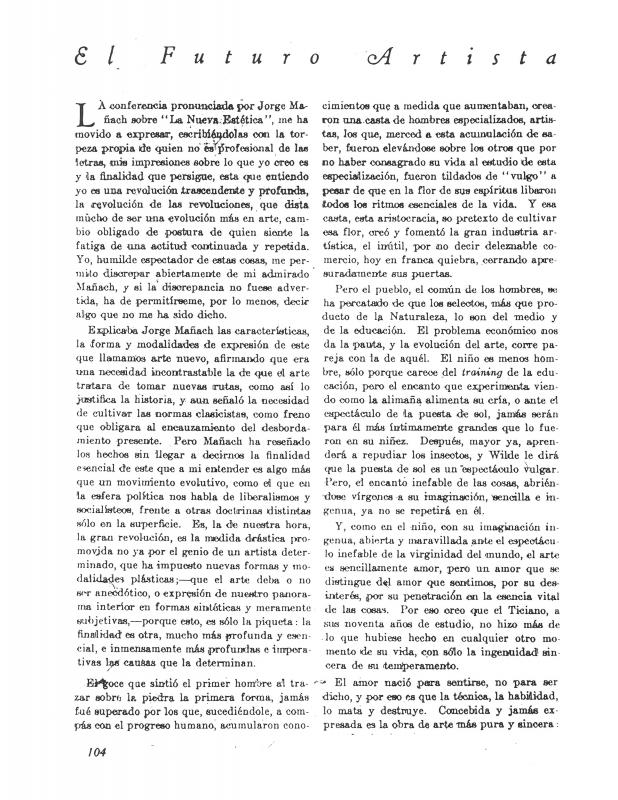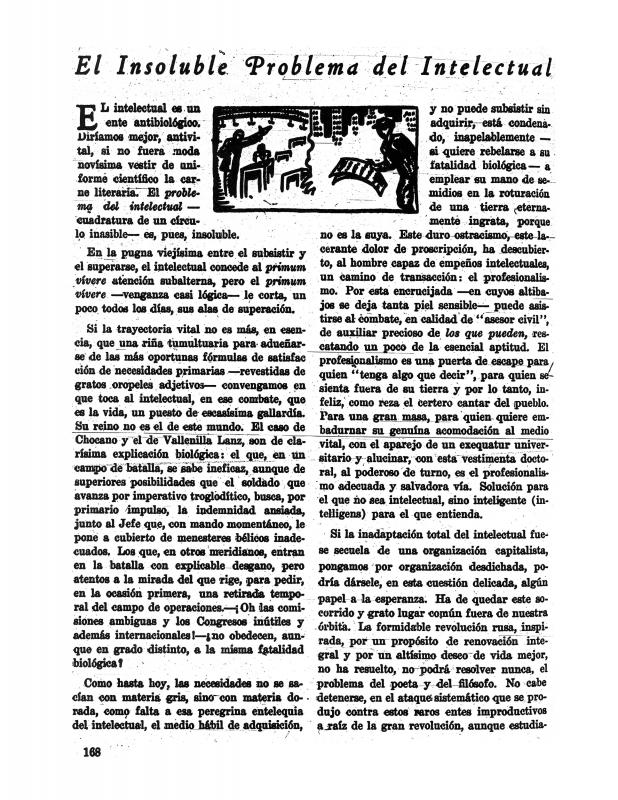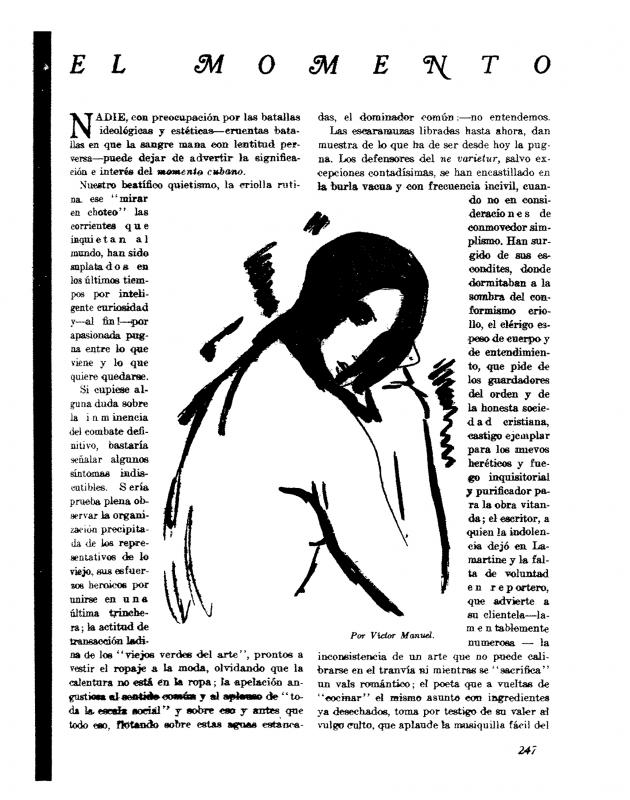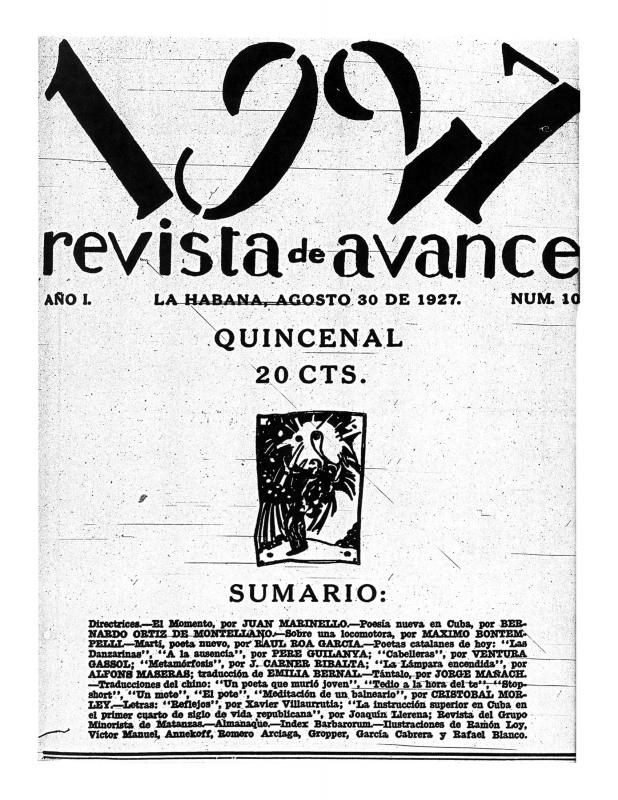Some artwork created by the Belgian painter Pierre Flouquet (1900–67) reached Cuba with the Cuban poet Mariano Brull, who brought some drawings with him when he returned from Europe. Flouquet himself arrived in Brussels when he was only six years old, and there, he studied art side by side with René Magritte, with whom he later shared a studio. Flouquet joined the avant-garde in Brussels and Paris and became familiar with modernist styles, especially Cubism and Futurism. He wrote criticism and participated in exhibitions while developing his theories on painting, through which he attempted to define the importance of a new kind of abstract painting that he called “Art for Art’s Sake.” In this article, Martí Casanovas attempts to place Flouquet’s style between the two most important aesthetic styles of the time: Cubism and Futurism. According to the Catalan journalist and art critic, while Flouquet’s work had the basic characteristics of both styles, it did not completely belong to either one. Casanovas’s analysis is limited in that it defines Futurism and Cubism in terms of purely emotional and formal elements. What this does reflect is the effort applied to developing an aesthetic theory related to ideology, or at least in terms of its social function and value. To Casanovas, Flouquet’s work did not go beyond the “exaggerated individualism and lack of human content” that was undermining modernist trends. Since modernist artwork was the legacy of Western ideology along with its art and intellectual traditions, these works reflected the individualistic values of the bourgeois classes, even if they arose in opposition to those values. [For other essays and texts published in Revista de avance, see the following in the ICAA digital archive: “Índice del Tomo I (Números 1 al 12 inclusive)” (anonymous) (doc. no. 1300106); by Martí Casanovas “Almanaque” (doc. no. 1299709), “Almanaque: Exposición Gattorno” (doc. no. 1298711), “El capitalismo y la inteligencia” (doc. no. 1299384), and “Nuevos Rumbos: La exposición de ‘1927’” (doc. no. 1280155); “[El arte nuestro debe ser instintiva o intuitivamente americano...],” by Víctor Andrés Belaúnde (doc. no. 832310); “[Basta con que revele una honda...],” by Carlos Préndez Saldías (doc. no. 832258); “Causerie sobre el Salón de Bellas Artes,” by Adia M. Yunkers (doc. no. 1298799); “[Creo que el artista americano...],” by Ildefonso Pereda Valdés (doc. no. 832328); “Dibujos escolares” (anonymous) (doc. no. 1299805); “Diego Rivera,” by Alejo Carpentier (doc. no. 1299962); “Eduardo Abela: pintor cubano,” by Adolfo Zamora (doc. no. 1280283); “El futuro artista,” by Eduardo Abela (doc. no. 1299789); by Juan Marinello “El insoluble problema del intelectual” (doc. no. 1299897), and “El momento” (doc. no. 1125671); “El prejuicio en el ritmo intelectual de las épocas,” by Francisco Ichaso (doc. no. 1299741); “El problema internacional de Centro América y Cuba,” by Fernando de los Ríos (doc. no. 1300090); “La cuestión del negro” (anonymous) (doc. no. 1280299); “La lección de Juan Gris,” by Juan Gris (doc. no. 1299946); “Marrozzini y la mediocridad: notas sobre declaraciones de Luigi Marrozzini,” by Lorenzo Homar (doc. no. 861634); “Martí: Poeta Nuevo,” by Raúl Roa García (doc. no. 1300003); “Nacionalismo y Costumbrismo,” by Severo García Pérez (doc. no. 1300058); “Nacionalismos en América,” by Eugenio d’Ors (doc. no. 1299757); “Nota de los 5—2,” by Jorge Mañach et al. (doc. no. 1299930); “Programa de criolledad,” by Félix Lizaso (doc. no. 1125414); and “Vértice del gusto nuevo,” by Jorge Mañach (doc. no. 832383)].












